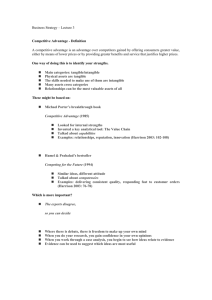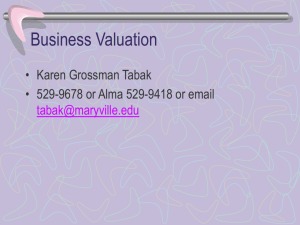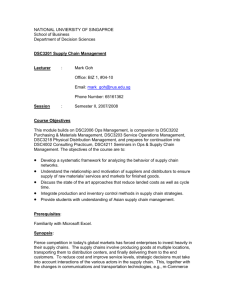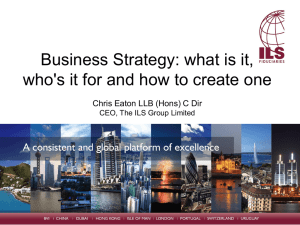The International Encyclopedia of Business and Management, 2nd Ed., (8... Volume 7.
advertisement
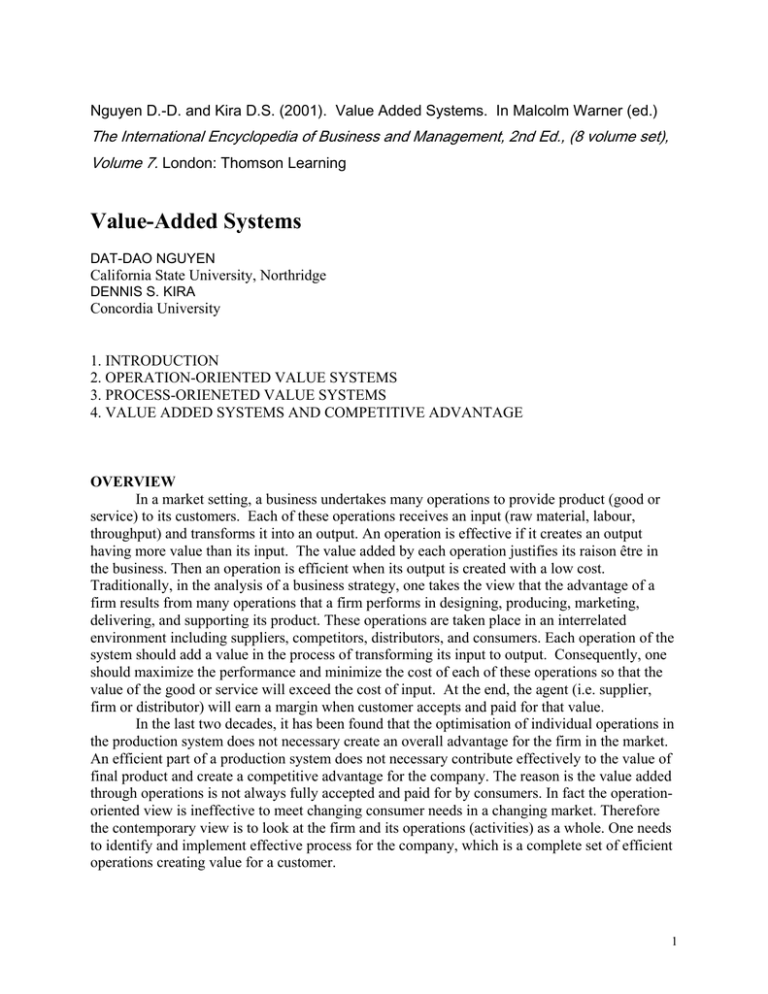
Nguyen D.-D. and Kira D.S. (2001). Value Added Systems. In Malcolm Warner (ed.) The International Encyclopedia of Business and Management, 2nd Ed., (8 volume set), Volume 7. London: Thomson Learning Value-Added Systems DAT-DAO NGUYEN California State University, Northridge DENNIS S. KIRA Concordia University 1. INTRODUCTION 2. OPERATION-ORIENTED VALUE SYSTEMS 3. PROCESS-ORIENETED VALUE SYSTEMS 4. VALUE ADDED SYSTEMS AND COMPETITIVE ADVANTAGE OVERVIEW In a market setting, a business undertakes many operations to provide product (good or service) to its customers. Each of these operations receives an input (raw material, labour, throughput) and transforms it into an output. An operation is effective if it creates an output having more value than its input. The value added by each operation justifies its raison être in the business. Then an operation is efficient when its output is created with a low cost. Traditionally, in the analysis of a business strategy, one takes the view that the advantage of a firm results from many operations that a firm performs in designing, producing, marketing, delivering, and supporting its product. These operations are taken place in an interrelated environment including suppliers, competitors, distributors, and consumers. Each operation of the system should add a value in the process of transforming its input to output. Consequently, one should maximize the performance and minimize the cost of each of these operations so that the value of the good or service will exceed the cost of input. At the end, the agent (i.e. supplier, firm or distributor) will earn a margin when customer accepts and paid for that value. In the last two decades, it has been found that the optimisation of individual operations in the production system does not necessary create an overall advantage for the firm in the market. An efficient part of a production system does not necessary contribute effectively to the value of final product and create a competitive advantage for the company. The reason is the value added through operations is not always fully accepted and paid for by consumers. In fact the operationoriented view is ineffective to meet changing consumer needs in a changing market. Therefore the contemporary view is to look at the firm and its operations (activities) as a whole. One needs to identify and implement effective process for the company, which is a complete set of efficient operations creating value for a customer. 1 1. INTRODUCTION To be able to survive and have a sustained growth, a firm should focus on its competitive advantage to satisfy consumer demand. The strategy taken should result in relative cost position and/or product differentiation for the firm. A cost position advantage results from a low cost material supply, an effective production, and an efficient distribution. Product differentiation results from distinct aspects such as high quality material, superior product design, effectively response to consumer needs. To analyse the competitive advantage, Porter (1985) proposed a framework in which a firm's activities are disaggregated into strategically relevant activities in a value chain. By studying the firm's value chain, one can understand cost behaviours, and the existing or potential sources of differentiation. Then a firm may gain competitive advantage by performing these strategic activities at lower cost and/or better than its competitors do. In Porter's framework, a firm's value chain is a part of a larger stream of activities, called a value system , performed by its business partners and competitors. In this value system, suppliers have value chains that create and deliver the input to be used in a firm. Then firm's products or services pass through the value chains of distributors (channels) to the buyer. Distributors perform additional activities that affect the buyer as well as influence the firm's activities. At last, a firm's product becomes part of its buyer's value chain determining buyer needs. In each part of the value system, the agents create added value as the product and/or service flow through the stream to final consumers. Consequently, gaining and sustaining competitive advantage depend on understanding not only a firm's value chain but also on how the firm takes part in the overall value system. Then one considers appropriate strategies to add value to the value chain such that the final products or services will create a profit margin for the firm and meet consumer needs. In production management, traditional view is to maximise individual activity performance, sometimes at the expense of total system performance. However, one has realised that an integrated approach to conducting business could avoid this zero-sum game and lead to win-win situation. In addition, consumer will not always accept and paid for the product and service created by the firm. This view takes a process-oriented approach proposed by Hammer (1996), in which one stands on an overall perspective to define what the firm can perform best to satisfy a consumer need. Then one designs an appropriate process, which is a complete set of coordinated operations to create value to be accepted and paid for by customers. 2. OPERATION-ORIENETED VALUE SYSTEMS The value chain model is an attempt to identify where actions should be taken to improve the firm's performance. Competitive opportunity exists at every cell of a matrix defined by support and primary activities. Corporate strategists can use this matrix of value activities to determine in which cells current systems are located, and therefore in which cells gaps exist, or by successively considering the potential opportunity for each cell. In addition, a firm's value chain is a part of a value system that is composed of the value chain of a company, those of its suppliers, its distributors, and its customers. By focussing on the linkages in the value system, a company can add value not only to itself but also to those in the value system. 2.1 Value Chain 2 The ultimate goal of any business is to provide value to its customers and earn a profit margin from its products or services. A business will be profitable if the value that it creates or adds is greater than the cost to produce goods or services. In Porter's framework, each firm has nine distinct value activities that are linked in a value chain. There are five primary activities to create, market, and deliver a product to buyers, and then service and support it. - Inbound logistics consists of receiving, storing, and distributing materials that are inputs to the product or service of the firm. These activities comprise of material handling, warehousing, inventory control, vehicle scheduling, and returns to suppliers. - Operations activities transform inputs into final products or services such as machining, packaging, assembly, equipment maintenance, testing, and facility operations. - Outbound logistics facilitates the distribution of finished products or services to buyers such as finished goods warehousing, material handling, delivery operation, order processing, and scheduling. - Marketing and sales activities facilitate the sale of products or services, such as advertising, promotion, sales force, channel selection, channel relations, and pricing. - Service activities provide repair and maintenance functions to enhance or maintain the value of the product, such as installation, repair, training, part supply, and production adjustment. Each of these operations adds an extra value as a product or service is created. Depending on the industry in which the firm operates, some operations may be vital to the competitive advantage of the firm. For instance, inbound and outbound logistics are the most critical operations to a distributor. But production is the most important operation for a manufacturer. However, all the categories of primary activities exist to some degree in any firm and play some role in its competitive advantage. These above primary activities are made possible with the four support activities. Each category of support activities could be divisible into a number of distinct value activities that are specific to a given industry. - Firm infrastructure includes organisational activities and functions that support the value chain. A firm infrastructure consists of general management, planning, finance, accounting, legal, government affairs, and quality management. Unlike other support activities, firm infrastructure support the entire chain instead of individual activities. - Human resources management relates to recruiting, hiring, training, and providing employee compensation and benefits. Human resource management affects competitive advantage in the firm through the cost of hiring, training, and its role in the assignment of skills to tasks, and motivation of employees. - Technology development activities improve a product or service with related knowhow, procedures, technology embodied in process equipment specific to the operation of the firm. Technology development takes forms in basic research, product design, media research, process equipment design, and servicing procedures. Some technology development is related to the product and supports the entire chain, while others are associated with particular primary and support activities. - Procurement refers to the function of purchasing inputs to be used in the firm's value chain such as necessary materials, supplies, machinery, and building for the primary activities. The dispersion of procurement function throughout a firm may obscures the magnitude of total purchases such that many purchases receive less scrutiny than others do. In many cases, the cost of procurement activities may have a large impact on the firm's overall cost and differentiation. 3 Depending on their goals and objectives, the value chains of firms in an industry differ. A specific firm's value chain may differ in competitive scope from that of its competitors, representing a potential source of competitive advantage. How each activity is performed combined with its economics will determine whether a firm is high or low cost relative to competitors. The performance of each value activity will also determine its contribution to buyer needs and differentiation. Although firms in the same industry may have similar chains, differences among value chains of competitors are the main source of competitive advantage. A firm's value chain in an industry may vary for different items in its product line, different buyers, geographic areas, or distribution channels. In competitive terms, value is defined as the amount buyers are willing to pay for the goods or service that a firm provides them. Value for a firm is measured by total revenue derived from the price and the units of product sold. A firm is profitable if the value, which it commands, exceeds the costs involved in creating the goods or service. In the value chain, value activities are the physically and technologically distinct operations that a firm performs to create a product valuable to its buyers. Margin is the difference between total value and the collective cost of performing value activities. Although value activities are building blocks of competitive advantage, the value chain is a system of interdependent, linked activities. Linkages are relationships between how one value activity is performed and the cost or performance of another. Competitive advantage may derive from linkages among activities as well as from the individual activities themselves. Linkages can lead to competitive advantage through optimisation and coordination. Linkages often reflect tradeoffs among activities to achieve a same overall performance so that the firm must optimise the linkages between activities to achieve competitive advantage. Linkage may also raise the question on the coordination of activities so that the firm can reduce cost and/or enhance differentiation. The firm's cost or differentiation is not solely the result of reducing cost or improving performance in each value activity individually, but it should be considered in the value chain and value system as a whole. Linkages can take place in many forms. Obviously, one has linkages between support and primary activities. The more subtle linkages are those between primary activities themselves. The most difficult ones to recognise are those linkages involving activities in different categories or different types. Linkages among value activities arise from the following causes: (1) the same business function can be performed in many alternative ways by linking different activities; (2) the cost or performance of direct activities could be improved by further effort in indirect activities; (3) activities performed inside the firm may reduce the cost to service a product in the field, (4) quality assurance inside the firm can be performed in many alternative ways. Exploiting linkages usually requires information on the cross-functional activities of the firm that allows optimisation or coordination to take place. Competitive scope can create advantage to the firm as it has influence on the configuration and economic of the value chain. There are four dimensions of scope that affect the value chain: - Segment scope is to serve different product or buyer's needs segment. Depending how many segments or products that the firm intends to serve or produce, the interrelationship of activities in its value chain will define a narrow or large scope. 4 - Vertical integration aims at the division of activities between a firm and its suppliers, distribution channels, and buyers. A firm can purchase semi-product from suppliers instead of fabricating them. Similarly, a firm may let its distribution channels perform the delivery, marketing, and service functions. Or the firm can let consumer do some activities in the final goods such as 'do-it-yourself ' products. - Geographic scope may allow a firm to reduce cost or enhance differentiation by sharing and/or coordinating value activities used to serve different geographic areas. The coordination may lead to division of value activities such that a branch in geographic area does not have its own complete value chain but just carries some value activities of the corporate chain. - Industry scope involves interrelationships among the value chains of business units in related industries. The interrelationships may exist in any primary (e.g., shared sales forces) as well as support (e.g., joint research and development) activities. A firm may exploit the benefits of broader scope internally or it may form coalitions with other firm in the form of joint ventures, licenses, and supply agreements. Coalition involves coordinating or sharing value chains with the partners to broaden the effective scope of the firm's chain. Competing in related industries with coordinated value chains can lead to competitive advantage through interrelationships. VALUE FIRM INFRASTRUCTURE HUMAN RESOURCE MANAGEMENT TECHNOLOGY DEVELOPMENT PROCUREMENT INBOUND LOGISTICS OPERATIONS OUTBOUND LOGISTIC MARKETING & SALES SERVICE COST MARGIN Figure 1: Value Chain (Adapted from Porter, 1985) 5 2.2 Value Systems Linkages also exist between a firm's chain and the value chains of suppliers and channels. Suppliers produce a product or service that a firm uses in its value chain, and suppliers' value chains also influence the firms at other contact points (generally referred to as an extended value chain). For instance, suppliers can reduce firm's inventory, inspection, and handling cost. These linkages can significantly affect a firm's cost and differentiation. It is possible to benefit both the firm and suppliers by influencing the configuration of suppliers' value chains to jointly optimise the performance of activities, or by improving coordination between a firm's and suppliers' chains. Distribution channels have value chains through which a firm's product flows to final consumers. Channel performs activities such as sales, advertising, and display that may substitute for or complement to the firm's activities. There are multiple contact points between a firm's and channels' value chains in activities such as sales force, order entry, and outbound logistic. The channel mark-up over a firm's selling price represents a large proportion of the final price to the end users. Coordination and joint optimisation with channels can lower cost or enhance differentiation. Buyers also have value chains, in which a firm's product represents a purchased input. Buyers could be industrial, commercial, institutional, or individual. Individual buyers in households purchase many products for a wide range of activities. The value created in a buyer's chain is the perception of the buyer on the utility of the purchased product or service. It is difficult to construct a value chain that encompasses everything a household and its members do. But one can always construct a representative chain for household for analysis purpose. A firm's differentiation stems from how its value chain relates to its buyer's chain. It is a function of how a firm's physical product is consumed in a particular buyer activity and all other contact points between a firm's value chain and buyer's chain. Value is created when a firm creates competitive advantage for its buyers either by reducing the buyers' cost or increasing buyers' performance and/or satisfying their needs. Firm Value Chains Supplier Value Chains Firm Value Chain Distributor Value Chains Buyer Value Chains Figure 2: Value System (Adapted from Porter, 1985) 6 3. PROCESS-ORIENTED VALUE SYSTEMS The traditional view decomposes processes into specialized tasks or operations and then focussed on improving performance of these tasks. Current organizations are almost task-centred enterprises. In a changing environment of contemporary business, the competitive advantage is to design processes to respond quickly to what the market actually demand. The persistent problem that companies being faced with could not be addressed entirely by means of task improvement. In our global economy, processes are inhibitors and determinants of business success, and only process-centred companies will be able to deal with them. The current problems that afflict modern organizations are not task problems but process problem. The reason that one cannot deliver results in a timely manner to meet consumer demand is not that individual activities are performed slowly and/or inefficiently. It is because activities, regardless how efficient they are performed, are unnecessary to achieve the desired result. The delays result from ineffective activities in the process. In addition, the firm is inflexible in response to consumer need not because one is locked into a fixed ways of operating but from the lacks of understanding how individual tasks combine to create a final result. High costs may not result from individual tasks that are expensive but due to the costly coordination these of individual tasks so that the final product can be delivered to customers. Therefore, problem lies not in the performance of individual tasks and activities, the unit of work, but in the processes, how the unit fit together in a whole. Process centring means that people in the organization recognize and focus on their processes to see if all the tasks together produce the results they are supposed to for the customer. Process is a complete set of activities that together create value for a customer. The difference between activities (tasks, operations) and process is the difference between part and whole. A task is a unit of work, a business activity normally performed by one person. In contrast, a process is a related group of tasks that together create a result of final value to a customer. None of these tasks by itself creates value for the customer. Only when they are all put together do the individual work activities create value. Business entities are composed of business processes such as purchasing raw materials, manufacturing products, taking orders, and distributing products to buyers. Each of these processes will create value and add it to the products as they go through the value chain and value system. A process is comprised of many work activities. However, not all activities in a process are beneficial to the firm. One can differentiate the value created activities in three broad categories. - A customer-value-added activity is a work that a customer is willing to pay for, such as turning raw materials into goods. - A business-value-added activity is a work that is essential to managing a firm's organisation. - A non-value-added activity is a work that customers will not pay for and that does not result in an increase value to the firm. 7 To be profitable, a firm has to design/redesign its business processes in order to - Maximise customer-value-added activities so that the products will gain the acceptance of consumer in terms of satisfying their needs and utilities. - Minimise the cost by maximising the efficiency of business-value-added activities. - Eliminate non-value-added activities by maximising the effectiveness of business activities. Companies moving to process centring do not create or invent their processes. The processes have always existed to produce the company's output, but in a fragmented, invisible, unnamed, and unmanaged. A process centring strategy recognises and identifies these processes and ensures everyone in the company being aware of them and their importance to the company. Then the company should manage processes in a permanent manner, strive for ongoing improvement and measure how well the processes being performed based on customer perspective (satisfaction) and company perspective (financial cost and asset utilization). A process perspective does not see individual tasks in isolation but the entire collection of tasks that contribute to a desired outcome. Everyone should not be concerned exclusively with his/her own limited responsibility and how well it is met. If not, it results in working at cross-purposes, misunderstanding and the optimisation of the part at the expense of a whole. Process work requires that everyone involved be directed toward a common goal so that no conflicting objectives will impair the common effort. To reengineer current processes, unnecessary tasks are eliminated, tasks are combined and reorganized, information is shared among people involved in a process so that improvements are realized in speed, accuracy, flexibility, quality, service, and cost. Traditional techniques for formulating strategy normally first concentrate on identifying potentially attractive markets and business and then look at whether it is feasible to enter them. A process-centred approach starts by considering possibilities of what a company might be able to do well, and then looking to see which are worthy of implementation. From a process perspective, an organization considers the following strategies (Hammer, 1996): Intensification: improving processes to serve current customers better. The goal is to reengineer the current processes, eliminate ineffective operations. Extension: using efficient existing processes to enter new markets to gain competitive advantage Augmentation: expanding processes to provide additional services to current customers. Conversion: taking a process that the company performs well and performing it as a service to other companies. Innovation: applying existing processes that one performs well to create and deliver different goods or services Diversification: creating new processes to deliver new goods or services. 4. VALUE-ADDED SYSTEMS AND COMPETITIVE ADVANTAGE The value-added concept suggests that one must examine each component of a process in terms of the value that components add to the final product. If an activity, an operation, a linkage adds no value, eliminating it may improve productivity. Value is added through the processes by which raw materials are changed into semi-finished and then finished parts, and then through assembly into a marketable product that is packed and shipped to a customer or distribution 8 centre. What may not be recognised is that many activities may add considerable cost to a product but no value at all. For instance, manually counting and handling inventory, or sorting out defects rather than having a defect-free process are typical procedures that add cost but not value. The way to achieve excellence is to involve everyone in the value chain (employees of the firm) and value system (business partners) in detecting and elimination processes that do not add value. Consequently, the selection of appropriate production process can be based on a valueadded analysis. This analysis focuses on how the works are combined in processes that clearly add to the worth of product in terms of meeting the customer's expectations and needs. The customer will reluctantly pay more than the perceived value of the goods or service, regardless of how much it cost to produce. This is called non-cost principle as it emphasises that value instead of cost will determine margin earning from a good or service. From this perspective, quality, reliability, appearance, service, and specific features make up the customer's perception of value. For value to be added, some transformation activities, some material conversion in production, must take place effectively and efficiently. In manufacturing, one can address value-added by defining the key manufacturing tasks, those in which failure would jeopardise the firm's survival. Value-added processes or activities must be emphasised in any analysis of performance and opportunities for improvement to achieve a competitive edge. One way to describe the desired result of value-added manufacturing is the maximisation of the contributions of everyone involved in the system, as contrasted to the minimisation of the direct labour content of the product. The effort includes each of the following: - Eliminate activities and related costs that add no value. - Reduce lead times in transport, internal flows, supplier response, communications, and customer need schedules. - Identify way to bring products to the market more quickly and with less debugging - Improve product manufacturability by working with manufacturing engineering and the tool and die shop. - Achieve fitness for use and strive for quality throughout the system. A large number of work activities add considerable cost to a product but add no value at all. These activities are defined as waste. American Production and Inventory Control Society (APICS) addresses four categories of waste: - Inventory takes up space and ties up capital. - Poor quality consumes material, time, capacity, and energy without any usable output. - Lead time makes the schedule rigid and requires an investment in replanning capability to make the inevitable adjustments. - Material movement reflects the distance a part travels in being processed and then assembled, the space and equipment and people involved in carrying out the movement, and the energy absorbed. Value-added system can become a driver for motivating creative, inspired employee needed to put organisations on a sustained learning and improve curve. It offers a focus for the productivity effort in which involved people want to engage and avoids over-specification as well as escape to the 'departmental' syndrome. In a supply chain, decision made in one stage of operation, i.e., value activity, will influence operational performance in other stages. Linking together the supply chain stages in an 9 effective process will be an important success of firms engaging in supply, manufacture, and distribute products globally. In gaining competitive advantage, information technology (IT) is an important support activity that can be used to perform primary activities effectively and efficiently. Modern managers should use the value chain and value-added system concept to determine where and how IT/S can add value to the firm. They should identify activities in the chain, determine cost and value of each activity, and analyse how and where It can add value. The advance in hardware and software technology has increased manufacturing flexibility, transportation speed, and information availability, and along with increased management complexity. Generally, IT can provide value added and competitive advantage in the following ways: - IT improves the use of knowledge in activities of the value chain and value system. - IT can improve products or services by increasing quality, reducing costs, or adding desirable features. - IT provides timely and reliable information to improve decision-making process. - IT improves communication between internal as well as external business entities to increase efficiency in production and distribution. A value-added system is composed of numerous operations and processes, and technological change influences the operation's process development implemented in the chain. Changes in materials, hardware, tooling, transportation, material handling, packaging, etc… ultimately affect the performance of the chain. The developments in manufacturing such as cellular manufacturing and automated material handling have increased throughput rates and responsiveness of plants. Developments in telecommunications and other technologies such as Electronic Data Interchange (EDI), global position systems providing organisations with access to operational real time information. In addition, the development of software technology for Enterprise Resource Planning (ERP) helps organisations manage efficiently their supply chain activities. Finally, electronic commerce (e-commerce) has the ability to transform the way firms perform activities and process all along the value chain. With the e-commerce enabled value system, firms can conduct their business on the Internet in a faster, leaner, flexible way and consequently have opportunities to add more value and earn larger profit margin. FURTHER READING Bell, R. and Burham, J. (1991) Managing Productivity and Change. Cincinnati, Ohio: SouthWestern Publishing. (Besides treatments on managing productivity and change, this book discusses how to create value added in manufacturing.) Davenport, T.W. (1992) Process Innovation: Reengineering Work Through Information Technology, Boston: Harvard Business School Publishing. (This book discusses the role of information technology in business process innovation and business strategy implementation.) Hammer, M. (1990) 'Reengineering Work: Don't Automate, Obliterate', Harvard Business Review July-August 1990: 104-112. (The classic article on why and how an enterprise should undertake a radical change of its business processes.) 10 * Hammer, M. (1996) Beyond Reengineering: How the Process-Centered Organization is Changing Our Work and Our Lives, New York: Harper Business. (The book proposes that what we do in reenginnering is not a drastic, radical change, but a process centering perspective in making strategies.) Hammer, M. and Champy, J. (1993) Reengineering the Corporation, New York: Harper Business. (This book examines the radical redesign of a company's processes, organisation and culture to achieve a quantum leap in performance.) Harmon, R.L. (1996) Reinventing the Business, New York: The Free Press. (This book discusses how to enterprises should implement contemporary and future technology in their business processes to make significant improvements in productivity, customer service, quality, and to gain a competitive advantage.) Kay, J. (1993) Foundations of Corporate Success: How Business Strategies Add Value, Oxford: Oxford University Press. (This book examines the strategic importance of business relationships and the architecture of the supply chain system.) * Porter, M.E. (1985) Competitive Advantage, New York: The Free Press. (The classic treatment of value chain, value system and how a firm formulates its strategies to gain competitive advantage.) 11



